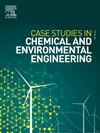Scale-up of oxidative desulfurization for sour diesel fuel: Modeling, simulation, and reactor design using Fe/AC catalyst
Q1 Environmental Science
Case Studies in Chemical and Environmental Engineering
Pub Date : 2024-11-15
DOI:10.1016/j.cscee.2024.101024
引用次数: 0
Abstract
Modeling and simulation at the bench scale are crucial for understanding industrial process behavior, particularly in oxidative desulfurization (ODS). Mathematical models are powerful tools in chemical process engineering, enabling the adjustment of process conditions without physical modifications, thereby optimizing process performance. In this study, a comprehensive mathematical model for the ODS of sour diesel fuel, supplied by the NRC refinery, was developed using O₂ as the oxidant and Fe/AC as the catalyst, based on experimental data from the literature. This model addresses key limitations of existing ODS models, including their limited applicability in industrial settings and challenges in scaling up while maintaining high sulfur conversion efficiency. By simulating an industrial batch reactor, the model advances current knowledge by providing a robust framework for scaling ODS processes. Optimal reaction conditions were determined to achieve ≥99 % sulfur conversion, with kinetic parameters of a reaction order of 1.2, an activation energy of 50 kJ/mol, and a pre-exponential factor of 9050 g(−0.2).h(−1). Scale-up results, based on these parameters, suggested optimal reactor dimensions of 1.3 m in diameter and 2 m in length. The batch reactor scale-up was conducted using the gPROMS software, yielding insights that can be applied directly to industrial reactors. Ultimately, this model contributes to the field by offering a scalable, practical approach to ODS reactor design and optimization, aiding the production of cleaner diesel fuels in compliance with stringent environmental standards.
含硫柴油氧化脱硫的放大:Fe/AC催化剂的建模、仿真和反应器设计
实验规模的建模和模拟对于理解工业过程行为,特别是氧化脱硫(ODS)至关重要。数学模型是化学过程工程中强大的工具,可以在不进行物理修改的情况下调整过程条件,从而优化过程性能。本文在文献实验数据的基础上,以O₂为氧化剂,Fe/AC为催化剂,建立了NRC炼油厂含硫柴油ODS的综合数学模型。该模型解决了现有ODS模型的主要局限性,包括它们在工业环境中的适用性有限,以及在保持高硫转化效率的同时扩大规模的挑战。通过模拟工业间歇式反应器,该模型通过提供扩展ODS过程的鲁棒框架来推进当前的知识。确定了硫转化率≥99%的最佳反应条件,反应动力学参数为1.2级,活化能为50 kJ/mol,指前因子为9050 g(−0.2).h(−1)。基于这些参数的放大结果表明,反应器的最佳尺寸为直径1.3 m,长度2 m。间歇式反应器放大是使用gPROMS软件进行的,产生的见解可以直接应用于工业反应器。最终,该模型为ODS反应器的设计和优化提供了一种可扩展的实用方法,有助于生产符合严格环境标准的更清洁的柴油燃料,从而为该领域做出了贡献。
本文章由计算机程序翻译,如有差异,请以英文原文为准。
求助全文
约1分钟内获得全文
求助全文
来源期刊

Case Studies in Chemical and Environmental Engineering
Engineering-Engineering (miscellaneous)
CiteScore
9.20
自引率
0.00%
发文量
103
审稿时长
40 days
 求助内容:
求助内容: 应助结果提醒方式:
应助结果提醒方式:


